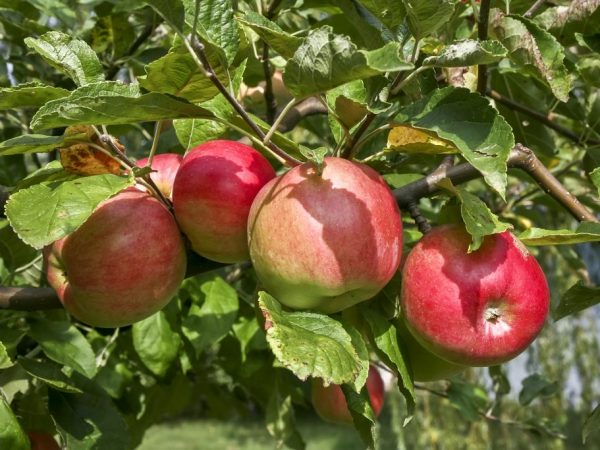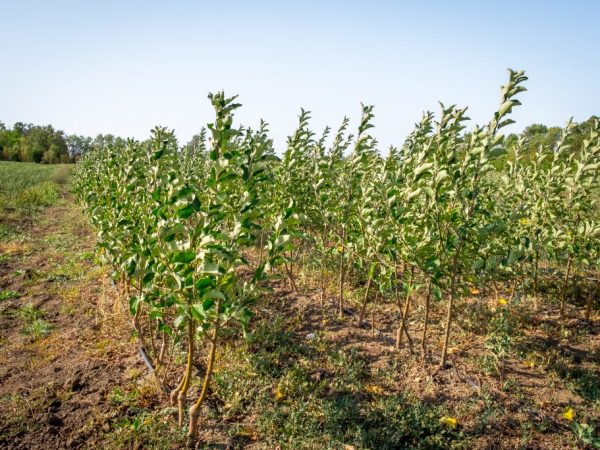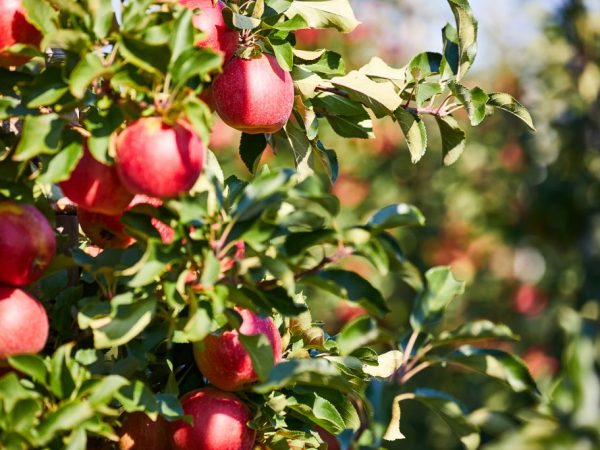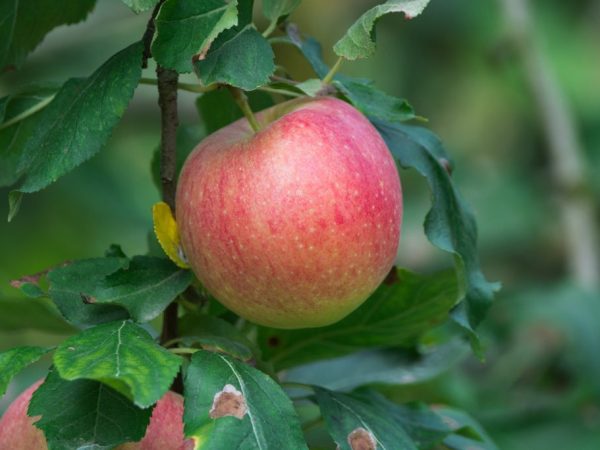Varietal features of the Zhigulevskoe apple tree
The fast-growing and high-yielding apple tree Zhigulevskoe was obtained by crossing two varieties - the American Prize Wagner and the domestic Borovinka ordinary. This tree, which is resistant to disease and cold, has become widespread not only in Russia, but also in other countries of the world.
- Variety characteristic
- Description of the tree
- Description of fruits
- Growing regions
- Advantages and disadvantages
- Growing rules
- Selection of seedlings
- Seat selection
- Technology
- Care
- Watering
- Loosening and weeding
- Fertilizers
- Pruning and shaping the crown
- Pollination
- Diseases and pests
- Harvesting and storage
- Types of rootstocks
- Growing in different regions
- Gardeners reviews

Varietal features of the Zhigulevskoe apple tree
Variety characteristic
This culture was taken as a basis for breeding new varieties - Malychenkovskoe and Utes.
Description of the tree
- medium-sized tree - maximum height is 3 m;
- intensively grows young shoots - 20-25 cm per year;
- the crown is wide, pyramidal;
- leaves are dark green, oval;
- large snow-white flowers;
- the central conductor is thick.
Description of fruits
The fruits of the variety have the following characteristics:
- apples of large size, spherical shape (average weight - 150-300 g);
- there are small bumps on the oily peel;
- fruits are two-colored - yellow with red stripes and a bright red barrel;
- the pulp is tender, sweet and sour, creamy, with a fine-grained structure;
- strong aroma;
- the chemical composition is balanced - apples of the Zhigulevskoye variety contain a whole range of vitamins and minerals. The calorie content of 100 g of the product is 50 kcal.
Growing regions
The Zhigulevskoye apple tree has poor winter hardiness, so it is advisable to grow it in the southern and central regions of the country (for example, in the Moscow region). The variety was most widespread in the Ryazan, Astrakhan regions, Krasnodar Territory, on the territory of the Middle and Lower Volga regions.
Advantages and disadvantages
The description of Russian culture includes several of its important advantages:
- early maturity and intensity of growth - the first crop appears in the third or fourth year of cultivation;
- high yield rates - 7-8 kg of apples from one tree (the peak yield falls on the tenth year of cultivation);
- fruits have a marketable appearance and excellent taste;
- increased resistance to scab and other fungal and viral infections;
- the fruits stay on the tree for a long time, during the collection process they are practically not damaged;
- shelf life without loss of original taste and presentation is 2.5-3 months;
- long-term fruiting - 3-4 harvests can be removed per season;
- ripening occurs in early September, and in regions with dry summers - in the last decade of August.
There are also several disadvantages of the variety:
- low winter hardiness;
- exposure to sunburn;
- the apple tree of the Zhigulevskoye variety is often damaged by the moth;
- with age, fruiting worsens - an old tree bears fruit every 2 years, the fruits become smaller.
Growing rules

Planting seedlings only in warm ground
The best time to plant this crop is the first or second decade of April. By this time, the soil will warm up well, all the snow will melt and the threat of return frosts will pass.
Autumn planting of the Zhigulevskoe apple tree is suitable for the southern regions, because in this territory, autumn is protracted, and when planted in early or mid-September, the seedling manages to prepare for the winter cold and get stronger.
Selection of seedlings
For planting, it is better to use one- or two-year-old seedlings from the nursery. So you can be sure that this is a real grade. A grafted seedling with the following characteristics will be a good planting material:
- well-developed, elastic root system with several fibrous roots at least 30 cm long;
- the bark on the central conductor and shoots should be smooth, without injuries and signs of damage from diseases and pests;
- the vaccination site must be healthy, evenly covered with bark;
- the optimal height is 60-70 cm.
If you have a seedling with an open root system, then before planting its roots should be soaked in a clay mash (3 kg of clay per 3 l of water). To restore the water balance, it will take 5-6 hours of soaking.
All roots that are broken or mechanically damaged must be cut off with a sterile knife or pruner. Places of cuts are powdered with charcoal.
Apple tree seedlings Zhigulevskoe with a closed root system do not need to prepare for planting, you only need to remove the protective material from the roots before planting.
Seat selection
For the cultivation of an apple tree of the Zhigulevskoe variety, loamy soil with a deep groundwater bedding - about 2.5 m is suitable. The tree grows well and bears fruit on fertile soil with a neutral level of acidity. For landing, choose a sunny place with protection from the winds.
All preparatory work for planting seedlings begins in early spring, two weeks before planting trees.
Dig a hole up to 1 m deep and 0.7 m wide. The dug soil is mixed with a bucket of peat, 300 g of wood ash, 40 g of potassium chloride and 300 g of superphosphate. It is not recommended to use nitrogen-containing preparations during planting, because they can cause root burns.
Technology
The process of planting Zhigulevskoe apple trees consists of several stages:
- the bottom of the pit is sprinkled with broken stones, crushed stone or pebbles in order to avoid stagnation of moisture in the future;
- then half-fill it with prepared fertile soil;
- on the formed mound, the roots of the apple tree are laid and leveled;
- a peg made of metal or wood is installed next to it for support;
- the roots are sprinkled with earth without fertilizers, tamped and trampled.
When planting in groups, the distance between trees is maintained - 4-5 m.
After planting, dig 2-3 holes at a distance of 50 cm from the trunk and water the tree with 10-15 liters of water. In order to avoid drying out of the soil and roots, the near-trunk zone is mulched with peat or garden soil. The tree is tied to a peg with a rope or twine.
When planting, it is important to follow one rule - you need to deepen the seedling so that the root collar is above the surface of the soil, otherwise the risk of rotting is inevitable.
Care

Excellent harvest
According to the description of the Zhigulevskoye apple tree, it needs standard care, which is no different from other fruit trees.
Watering
In the first years of life, seedlings need a lot of moisture in order to quickly build up the aboveground and underground part. In a dry summer, at least 5 waterings must be carried out. Moisturizing is carried out early in the morning or in the evening after sunset. This will avoid burns.
In addition, in the evening, sprinkling of the crown can be carried out, which will improve the decorative properties of the tree, saturate the aboveground part with moisture and protect it from the invasion of parasites.
Loosening and weeding
It is necessary to loosen the soil before each watering, which will increase its moisture and air permeability.Also, as the apple tree grows in the garden, it is necessary to remove weeds, which are an excellent medium for the appearance of various infections and pests.
To improve the access of water to the roots, gardeners make several holes with a crowbar at a distance of 50 cm from the trunk.
Fertilizers
In the first two years, the trees have enough nutrients that were laid during planting.
Starting from the third year of cultivation, fertilizers are applied according to the following scheme:
- at the beginning or in the middle of April, the soil around the trunk circle is sprinkled with urea - 500 g of the substance is consumed per tree;
- in the summer, when the active phase of the growing season begins, the tree is fertilized with nitrogen-containing preparations (azophos or nitrophos) according to the instructions on the package;
- at the stage of budding and pouring the fruits, a complex composition of superphosphate and potassium salt is introduced (100 g per 1 m²).
After each feeding, the garden is watered abundantly to improve the absorption of nutrients.
Pruning and shaping the crown
Forming the crown of the Zhigulevskoye apple tree is a mandatory care procedure that will help create a decorative aboveground part, protect the tree from damage by diseases and pests, and also improve the quality and quantity of the crop.
- The first tree cutting is carried out immediately after planting - all branches, incl. and the center conductor are shortened by one third.
- The next year, they begin to form the crown - the central branch is cut 20 cm from the top, the 3 thickest ones are selected from the skeletal ones, the rest are cut “into a ring”.
- In the third year, a row of the second order is formed according to the same principle, only 2 branches are left in a row.
- Sanitary pruning is carried out annually (in early spring - before the start of sap flow). Sick branches, broken by the wind and frozen over, are trimmed to healthy wood.
- A rejuvenating haircut is carried out for trees that have stopped growing young shoots and have begun to produce small fruits in small quantities. In this case, a cardinal pruning is required - all 5-year-old branches are removed "on the ring", and the young are trimmed by a third of the length.
After each pruning, the cuts are sprayed with copper sulfate, and then smeared with garden varnish. This will help avoid infection of the wounds and promote their early healing.
Pollination
This is a self-fertile crop, so it needs pollinators in the neighborhood. For this, autumn pollinator varieties that bloom simultaneously with the Zhigulevskoye apple tree are suitable - Kutuzovets, Antonovka, Anis striped, Borovinka.
When planting in groups, it is important to maintain a distance between trees of at least 5 m.
Diseases and pests

Apple trees require proper care
The characteristic of the variety includes resistance to diseases, but in conditions of unfavorable weather and in the absence of proper care, the tree is affected by several types of infections and parasites.
- Powdery mildew. Leaves and shoots are covered with a white bloom, which eventually becomes wet and begins to rot. The preparations "Skor" and "Topaz" will help to cope with the fungus. Recipe - 2 ml of substance per 10 liters of water.
- The fruit moth is capable of destroying more than 50% of the crop. For prophylaxis, double pollination of the crown with an infusion of wormwood (1 liter of grass per 5 liters of water) is required. The interval between treatments is a week. It is also necessary to regularly remove fallen leaves from the site, in which the pest larvae can live.
- The apple tree is prone to sunburn, as a result of which cracks and wounds appear on the bark, into which harmful bacteria penetrate. The injured areas are cut with a sharp knife, and then treated with garden pitch. To avoid this, it is necessary to carry out regular whitewashing of trees (in spring and autumn).
- Hares and mice love to feast on the bark of the apple tree. To protect against them in the fall, the near-trunk zone is wrapped with a fine metal mesh (chain-link).
Before the onset of cold weather, the tree needs good shelter. Autumn preparation consists in the removal of all damaged organs and treatment with garden pitch.Also, the near-trunk zone is whitewashed with slaked lime, and after drying, it is spudded with earth. The bole is wrapped with roofing material, foil or spruce branches to protect it from freezing.
Harvesting and storage
The Zhigulevskoe apple variety is harvested in August-September. After harvesting, the fruit should lie down for a while to reach full ripeness. The maximum ripening time after harvest is 2-3 weeks.
Apples can be easily removed from the tree, are not damaged when dropped, which facilitates their further rejection and storage.
The optimum storage temperature for the crop is 0-4 ° C. Fruit does not need to be washed before placing it in wooden or cardboard boxes, otherwise it will quickly start to rot. Each fruit is wrapped in thick paper.
The second option is to lay the apples in layers. Moreover, each layer is covered with hay, sawdust or straw. The room should have good ventilation and low air humidity - within 55-60%. Average shelf life is about 90 days.
Types of rootstocks
Depending on the stock, this culture has several varieties:
- seed seedling. It is tall and late ripening - the tree gives its first fruits in the sixth or seventh year of life;
- medium-sized. The tree reaches 3-4 m in height, the first fruits begin to bear in the fourth or fifth year of cultivation;
- half-dwarf. The apple tree is compact, three meters in height, but it ages very quickly and ceases to bear fruit. Requires anti-aging pruning;
- dwarf. The crown is small - up to 2 m in height. A tree with early fruiting dates (in the third year after planting). Seedlings of this type need support and very good maintenance.
Growing in different regions
For the Moscow region, where the climate is mild, but cold winters are not excluded, this variety is ideal. The harvest ripens by the end of September or the beginning of October.
In Siberia, shale crown formation is used. All young growth is bent to the ground, fixed with staples. The soil around the seedling is mulched with a thick layer of peat. To increase air exchange, the earth around the near-trunk zone is periodically loosened.
These measures will provide the tree with good frost resistance. A similar growing method and tree care rules are used by gardeners in the Urals.
Gardeners reviews
Many gardeners fell in love with the Zhigulevskoye apple variety for its high yield, good keeping quality of fruits and excellent taste.
As practice shows, in regions with a cool climate, a tree gives no less amount of apples, if it is provided with careful care and good wintering.
Gardeners of the south note the frequent occurrence of burns on the trunk and skeletal branches. In spring and summer, the tree needs good sun protection.
The harvest is severely damaged by the moth, so some people prefer to grow other varieties of apple trees. Also, the tree ages very quickly and begins to yield small fruits - another disadvantage, because of which gardeners do not consider this variety one of the best.

